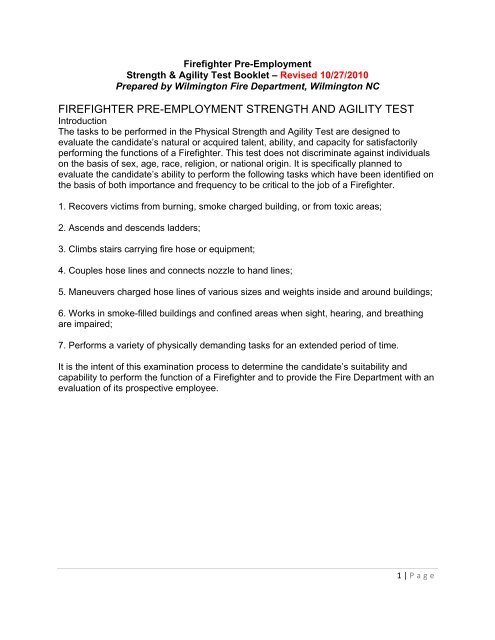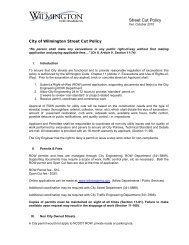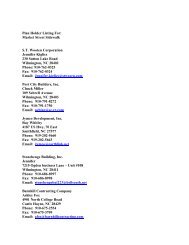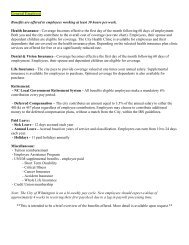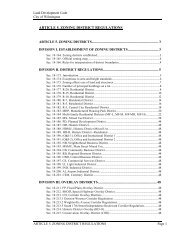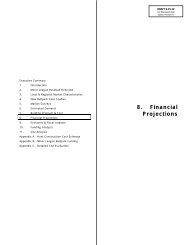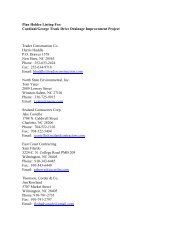FIREFIGHTER PRE-EMPLOYMENT STRENGTH AND AGILITY TEST
FIREFIGHTER PRE-EMPLOYMENT STRENGTH AND AGILITY TEST
FIREFIGHTER PRE-EMPLOYMENT STRENGTH AND AGILITY TEST
Create successful ePaper yourself
Turn your PDF publications into a flip-book with our unique Google optimized e-Paper software.
Firefighter Pre-Employment<br />
Strength & Agility Test Booklet – Revised 10/27/2010<br />
Prepared by Wilmington Fire Department, Wilmington NC<br />
<strong>FIREFIGHTER</strong> <strong>PRE</strong>-<strong>EMPLOYMENT</strong> <strong>STRENGTH</strong> <strong>AND</strong> <strong>AGILITY</strong> <strong>TEST</strong><br />
Introduction<br />
The tasks to be performed in the Physical Strength and Agility Test are designed to<br />
evaluate the candidate’s natural or acquired talent, ability, and capacity for satisfactorily<br />
performing the functions of a Firefighter. This test does not discriminate against individuals<br />
on the basis of sex, age, race, religion, or national origin. It is specifically planned to<br />
evaluate the candidate’s ability to perform the following tasks which have been identified on<br />
the basis of both importance and frequency to be critical to the job of a Firefighter.<br />
1. Recovers victims from burning, smoke charged building, or from toxic areas;<br />
2. Ascends and descends ladders;<br />
3. Climbs stairs carrying fire hose or equipment;<br />
4. Couples hose lines and connects nozzle to hand lines;<br />
5. Maneuvers charged hose lines of various sizes and weights inside and around buildings;<br />
6. Works in smoke-filled buildings and confined areas when sight, hearing, and breathing<br />
are impaired;<br />
7. Performs a variety of physically demanding tasks for an extended period of time.<br />
It is the intent of this examination process to determine the candidate’s suitability and<br />
capability to perform the function of a Firefighter and to provide the Fire Department with an<br />
evaluation of its prospective employee.<br />
1 | P age
<strong>FIREFIGHTER</strong> <strong>PRE</strong>-<strong>EMPLOYMENT</strong> <strong>STRENGTH</strong> <strong>AND</strong> <strong>AGILITY</strong> <strong>TEST</strong><br />
Instructions to the Candidate<br />
This test booklet has been provided to you for your use in preparing to take the Firefighter<br />
Pre-Employment Strength and Agility Test. You are encouraged to read this material<br />
carefully so that you will be familiar with the test components and procedures. Previous<br />
experience has demonstrated that familiarity with the test benefits the candidate.<br />
1. Waiver of Liability – You will be required to sign a Waiver of Liability before being<br />
permitted to take the test. This document states that you will assume full responsibility for<br />
any injuries occurring during the test.<br />
2. Practice Exercise – Included in this booklet is a list of suggested exercises which would<br />
be helpful in preparing you for the test.<br />
3. Suggested Clothing – You should appear at the Fire Training Ground wearing long pants,<br />
soft-soled or athletic shoes, and a shirt or top appropriate for the weather. Male candidates<br />
should also wear an athletic supporter. You will not be allowed to take the test if, in the<br />
opinion of the examiner, you are not appropriately dressed.<br />
4. Eating Before the Test – It is recommended that you do not eat at least one hour before<br />
you take the test.<br />
5. Instructions Given by Examiner – Before each test event the examiner will give you<br />
instructions concerning that event. You will be expected to listen to those instructions, ask<br />
questions if they are not clear, and to follow them in performing the event. You will be<br />
penalized if you fail to satisfactorily complete the events on the test as a result of a failure to<br />
follow instructions.<br />
6. Instruction Periods – An instruction period has been set aside. The purpose of this period<br />
is to provide you with instructions for the next event and to allow you time for preparations.<br />
You may also rest during this period if time permits. You will not be allowed to take more<br />
time than specified on the test materials.<br />
7. If You Do Not Feel Well – If you do not feel well enough to take the test, please notify<br />
your examiner. You will be rescheduled to take the test on another day. Once the test<br />
begins, you will be expected to continue.<br />
8. If You Are Injured – If you are injured while taking the test, you will be allowed to continue<br />
if you provide a written letter from a doctor granting clearance.<br />
9. Passing the Test – In order to pass the test, you must satisfactorily complete all of the<br />
events. If you fail any event, you will not be allowed to proceed through the remaining<br />
exercises. If you pass all events, your application will be allowed to continue to the next step<br />
of the process.<br />
2 | P age
10. Biological Measures – All candidate’s blood pressures and pulse rates will be checked<br />
by EMTs before any event begins. The EMT may deny the Candidate from participating,<br />
based on its findings, if participation would pose a risk to the wellbeing of the Candidate.<br />
Suggested Practice Exercises<br />
1. Climbing ladders<br />
2. Weight lifting<br />
3. Push-ups<br />
4. Chin-ups<br />
5. Running or jogging with weights<br />
6. Running in place<br />
7. Running stairs<br />
8. Climbing stairs with weights<br />
9. Making connections of garden hose or threaded pipe<br />
10. Dodge runs<br />
11. Wind sprints<br />
SECTION #1<br />
Event 1 – Ladder Climb<br />
For this event, the candidate will be required to wear a standard Firefighter’s helmet. The<br />
candidate is required to climb to the thirty foot (30’) level (indicated by a red mark) of an<br />
extension ladder which is placed at an angle supported by the drill tower and tied off. After<br />
reaching the prescribed height, the candidate will climb back down the ladder.<br />
Failure of the candidate to successfully complete this event will constitute failure of the test<br />
and the candidate will be dismissed. This event tests that a candidate does not suffer from<br />
acrophobia and is able to work from a ladder at a considerable height.<br />
Event 2 – Hose Coupling<br />
Three sections of 2-1/2” hose will be coupled together with one end connected to the<br />
coupling on the drill tower and with a nozzle attached at the other end. This hose will be<br />
stretched out in a straight line. On the command “ready-start”, the candidate will jog 25 feet<br />
to the nozzle, and beginning at the nozzle, disconnect the nozzle and each section of hose<br />
one at a time, folding each coupling back on the hose until all are disconnected including<br />
the connection to the drill tower. Candidate must then, in the reverse order, make all<br />
connections back to the nozzle, folding the nozzle back on the hose upon completion and<br />
jog back to the starting point. A demonstration will be made by the examiner. After each<br />
coupling is reconnected, the examiner will examine the connection. This event tests that the<br />
candidate has the ability to manipulate objects using his or her hands and arms as required<br />
in hose coupling and the use of other firefighting and rescue equipment.<br />
This is a timed event. Pass/fail time will be based on data from previous Strength and Agility<br />
tests. You will be informed of the pass/fail time before you start this event.<br />
Event 3 – Room Search<br />
3 | P age
The candidate will be outfitted with a self-contained breathing apparatus, turnout coat and<br />
helmet. The mask will be blacked-out as to limit the visibility of the candidate. This will<br />
simulate reduced visibility that firefighters encounter when entering a smoke-filled room.<br />
The candidate will enter the building, assume a crouched position, and proceed along the<br />
wall to his or her left. The candidate will continue around the entire room, returning to the<br />
starting location. The candidate will stay in contact with the wall the entire time during this<br />
exercise.<br />
This event tests a combination of the ability to work under stressful conditions and<br />
claustrophobia. The ability to rescue unconscious people from burning or smoke filled<br />
buildings using self-contained breathing apparatus is essential for satisfactory performance<br />
as a Firefighter.<br />
Section #2<br />
DESCRIPTION<br />
This is a timed assessment that consists of five (5) job-related tasks laid out in a continuous<br />
format. These five (5) tasks and the equipment needed are described in the following<br />
sections. Each task is separated by a minimum of fifty feet (50’) designed to create a cool<br />
down period between each task. There will be no running and/or jogging during any portion<br />
of this assessment. Running and/or jogging will constitute an automatic failure of the<br />
assessment. All safe lifting techniques and procedures will be observed at all times during<br />
the assessment. Assessors will demonstrate/explain each task as well as all proper lifting<br />
techniques. Tasks #1 through #5 should be completed consecutively at a deliberate pace.<br />
If at any time the Candidate should stop to rest or stop moving, he/she will be failed. Failure<br />
of the test will also occur if any of these tasks are not completed. Each candidate will wear<br />
a firefighting coat, helmet, gloves, and breathing apparatus. No mask will be worn.<br />
TASK #1 – VICTIM DRAG<br />
This task is designed to assess the Candidate’s ability to rescue a victim. The Candidate<br />
shall move a one hundred fifty pound (150#) mannequin from the starting point to a cone<br />
located twenty-five feet (25’) away and then back to the starting point. When the mannequin<br />
is first touched by the Candidate, the time will start. The Candidate will place the mannequin<br />
on the ground and proceed to the next task.<br />
TASK #2 – LADDER RAISE<br />
This task is designed to assess a single Candidate’s ability to lift, raise, properly set for<br />
climbing, and lower a twenty-four foot (24’) extension ladder. The Candidate will be assisted<br />
by two (2) firefighters during this task to ensure safety. The ladder will lie flat on the ground,<br />
fly section up, with the heel facing the wall. The Candidate will then lift the ladder to a<br />
vertical position and extend the ladder to a predetermined marking on the ladder.. The dogs<br />
will lock and the Candidate will then set the ladder at a seventy degree (70º) angle suitable<br />
for climbing. The reverse steps will be used to place the ladder back on the ground and<br />
proceed to the next task.<br />
TASK #3 – HIGH RISE PACK/STAIR CLIMB/HOSE HOIST<br />
This task is designed to assess the Candidate’s ability to lift and carry a one hundred foot<br />
(100’) high rise pack up three (3) flights of stairs, hoist an uncharged section of two and<br />
4 | P age
one-half inch (2-1/2”) hoseline with nozzle, and then return to the starting point. From the<br />
starting point, the Candidate will pick up the high rise pack and walk to the entrance of the<br />
drill tower, proceeding up the stairs to the third floor. After arriving on the third floor, the<br />
Candidate will place the high rise pack on the floor and proceed to the adjacent landing to<br />
raise the uncharged hoseline with the attached rope. The Candidate will then, in a hand<br />
over hand fashion, raise the hose up to the third floor. At the signal of the evaluator, the<br />
Candidate will lower the rope in a hand-over-hand fashion to the ground. The Candidate<br />
will then pick up the high rise pack and proceed back to the starting point. At no time will the<br />
Candidate skip or jump steps; all stairs must be touched on the way up and on the way<br />
down.<br />
TASK #4 – HOSE DRAG<br />
This task is designed to assess the Candidate’s ability to advance a charged one and threequarter<br />
inch (1-3/4”) hoseline. From the starting point, the Candidate will advance the<br />
charged hoseline one hundred feet (100’). The Candidate will then operate the nozzle and<br />
hit a target located twenty five feet (25’) away. The Candidate will then close the nozzle and<br />
place the nozzle on the ground and proceed to the next task.<br />
TASK #5 – EQUIPMENT CARRY<br />
This task is designed to assess the Candidate’s ability to pick up and carry two (2) power<br />
saws and advance them one hundred feet (100’). From the starting point, the Candidate will<br />
pick a power saw in each hand and walk to a predetermined point located fifty feet (50’)<br />
away. The Candidate will then return to the starting point and place the saws back on the<br />
ground. The assessment will be considered over and time will stop when the Candidate<br />
places the saws on the ground.<br />
5 | P age


